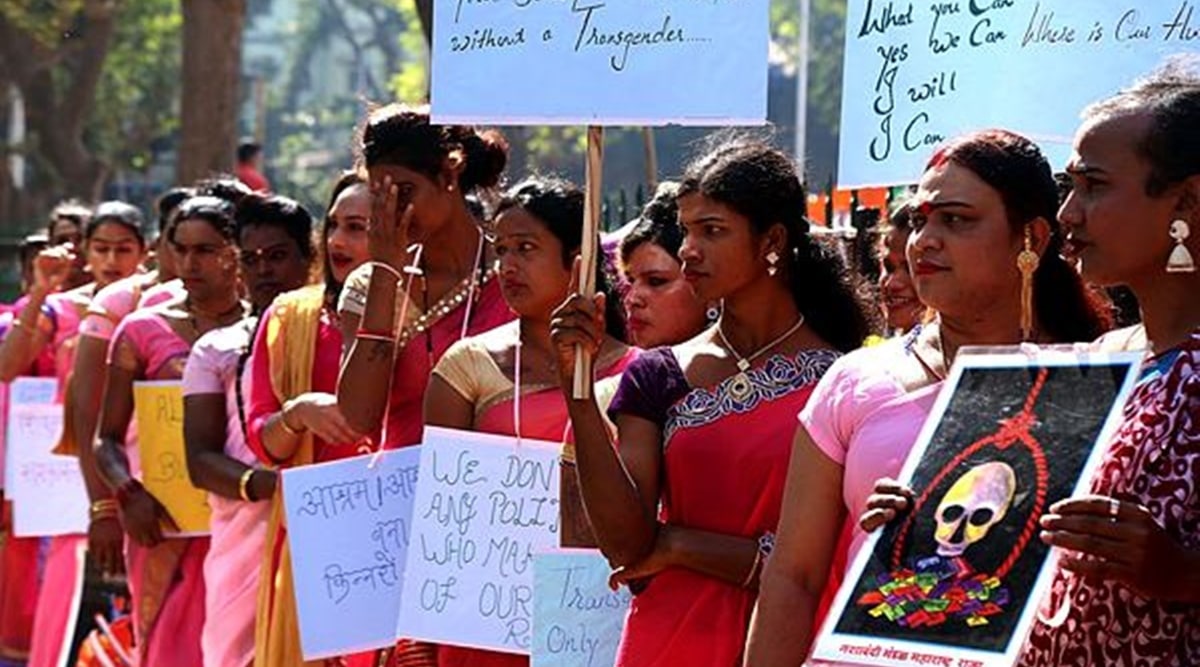 For most of us, our interactions with people from the Hijra and Kinnar community are limited to such brief interludes at traffic signals, on trains, or when they visit our homes for badhai. (Express File Photo)
For most of us, our interactions with people from the Hijra and Kinnar community are limited to such brief interludes at traffic signals, on trains, or when they visit our homes for badhai. (Express File Photo)Every time a Hijra person knocks on my car window and begs for money, my heart goes out to the thousands of Hijra community members who dot our cities’ traffic signals. Most of them have left their homes and stayed with community members from their gharanas, surviving by begging, badhai and sex work. I have often wondered where they go to pee when they are working at traffic signals — in cities that do not even provide basic facilities like transgender-inclusive washrooms. How are they navigating the overflowing public healthcare system, as the cisgender gaze tracks their every step and move? How are they navigating our public transport systems? Do they even have a bank account to deposit their savings? Before I can think through these questions and dare to ask them, the traffic light turns green and I move on. Of course, the car window doesn’t roll down.
For most of us, our interactions with people from the Hijra and Kinnar community are limited to such brief interludes at traffic signals, on trains, or when they visit our homes for badhai. The Hijra community is thus hyper-visible, as no one can ignore them, while also being invisible as no one thinks about them. But gradually the gears have started to shift. The NALSA vs Union of India judgment of 2014 was a path-breaking reform to give equal rights to the transgender community. It talked about the self-determination of gender, prevention of discrimination in all spheres of life, and spoke about affirmative action for the community.
Five years later, the Transgender Persons Protection of Rights Act was enacted and its Rules were notified. The National Council for Transgender Persons was formed. The Ministry of Social Justice and Empowerment, which is the nodal ministry for the welfare of transgender persons, came up with social measures like a National Portal for application for Transgender ID cards, the SMILE scheme, Garima Greh, scholarships, and very recently, the Ayushman Bharat TG Plus card that provides health insurance for transgender persons including gender-affirming care. While all this may sound like phenomenal progress as India celebrated 75 years of its Independence, there is a lot left to be done.
The Transgender Persons Act and Rules leave much to be desired as they have medicalised gender identity, diminished violence against trans persons, and don’t provide for reservations, which was directed in the NALSA judgment. As the Rules complete two years of their notification on September 29, many provisions that were to be implemented in these two years have not seen the light of day. Many states and UTs are yet to notify the rules, create separate washrooms for trans persons, and have gender-inclusive hospitals. It is a disgrace that something as basic as Transgender Welfare Boards have not been constituted in many states and UTs.
It may be worthwhile to note that the courts are doing some remarkable work in pushing the envelope for the rights of transgender persons. The Madras High Court, in a spate of judgments, has issued orders for reforming queerphobic curricula, banning conversion therapy, issuing a glossary for trans-sensitive media reporting, sensitisation at schools and among police personnel, etc. On the other hand, the implementation eats planning for breakfast as we see that just around 2 per cent of the official count of transgender persons in Census 2011 have been issued transgender ID cards, making them eligible for various social schemes from scholarships to health insurance.
It is also notable how the government, which shied away from listening to community voices during the passing of the Transgender Bill, has been shaky on its stand on the rights of queer persons. From opposing same-sex marriages to abstaining from voting for an independent expert at the UN on sexual orientation and gender identity, the state’s actions suggest the lack of an inclusive vision. The deeply patriarchal tint in our politics seems to be leaving its mark on the way new laws around reproductive health have been framed. Trans and queer people are systematically excluded from commissioning surrogacy, availing of artificial reproductive techniques, or seeking a legal abortion.
This situation makes us ask: Are we keen as a society to undo the historical wrongs committed against the transgender community and ensure equality of rights and opportunities or are we just resisting attempts at revealing our transphobia through cosmetic changes? It’s time to move beyond the rhetoric and symbolism and ensure substantive changes in our vision, policies, laws, and guidelines. After 75 years of our Independence, we cannot continue excluding a section of our society for the way they are born.
India at 100, to me, is a society where gender becomes redundant and is not used as a tool to exclude, discriminate or harass. It should be a nation where transgender people are sitting in Parliament and in the assemblies, shaping their destiny. It will be a country where being different will be celebrated.
The writer is associate professor, Department of Community Medicine, Hamdard Institute of Medical Sciences and Research, Jamia Hamdard, Delhi. This article is part of an ongoing series, which began on August 15, by women who have made a mark, across sectors